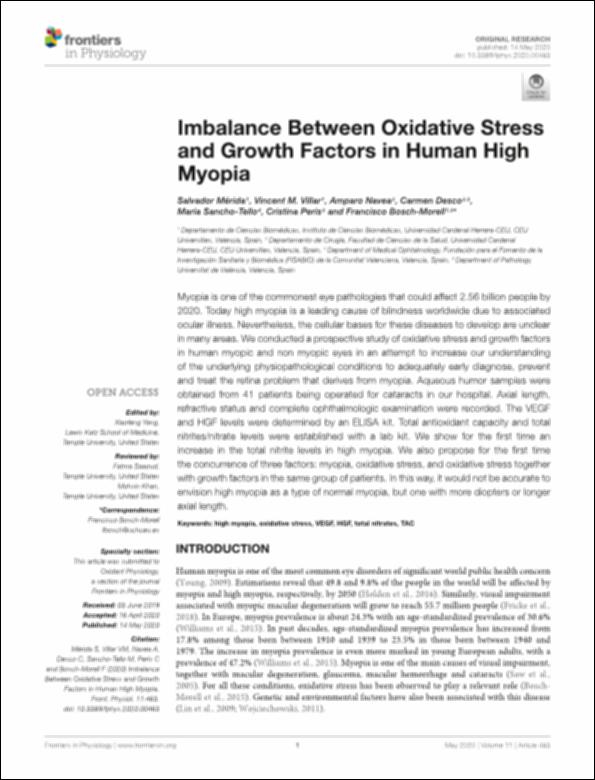Please use this identifier to cite or link to this item:
http://hdl.handle.net/10637/12678Imbalance between oxidative stress and growth factors in human high myopia
| Title: | Imbalance between oxidative stress and growth factors in human high myopia |
| Authors : | Mérida Donoso, Salvador Villar Amigó, Vicente Navea Tejerina, Amparo Desco Esteban, María Carmen Sancho Tello, María Peris Martínez, Cristina Bosch Morell, Francisco |
| Keywords: | Nitrates.; Estrés oxidativo.; Oxidative stress.; Growth factors.; Myopia.; Nitratos.; Crecimiento - Factores.; Miopía. |
| Publisher: | Frontiers Media. |
| Citation: | Mérida, S., Villar, V.M., Navea, A., Desco, C., Sancho-Tello, M., Peris, C. et al. (2020). Imbalance between oxidative stress and growth factors in human high myopia. Frontiers in Physiology, vol. 11, art. 463 (14 may.). DOI: https://doi.org/10.3389/fphys.2020.00463 |
| Abstract: | Myopia is one of the commonest eye pathologies that could affect 2.56 billion people by 2020. Today high myopia is a leading cause of blindness worldwide due to associated ocular illness. Nevertheless, the cellular bases for these diseases to develop are unclear in many areas. We conducted a prospective study of oxidative stress and growth factors in human myopic and non myopic eyes in an attempt to increase our understanding of the underlying physiopathological conditions to adequately early diagnose, prevent and treat the retina problem that derives from myopia. Aqueous humor samples were obtained from 41 patients being operated for cataracts in our hospital. Axial length, refractive status and complete ophthalmologic examination were recorded. The VEGF and HGF levels were determined by an ELISA kit. Total antioxidant capacity and total nitrites/nitrate levels were established with a lab kit. We show for the first time an increase in the total nitrite levels in high myopia. We also propose for the first time the concurrence of three factors: myopia, oxidative stress, and oxidative stress together with growth factors in the same group of patients. In this way, it would not be accurate to envision high myopia as a type of normal myopia, but one with more diopters or longer axial length. |
| Description: | Este artículo se encuentra disponible en la siguiente URL: https://www.frontiersin.org/articles/10.3389/fphys.2020.00463/full |
| URI: | http://hdl.handle.net/10637/12678 |
| Rights : | http://creativecommons.org/licenses/by/4.0/deed.es |
| ISSN: | 1664-042X (Electrónico). |
| Issue Date: | 14-May-2020 |
| Center : | Universidad Cardenal Herrera-CEU |
| Appears in Collections: | Dpto. Ciencias Biomédicas |
Items in DSpace are protected by copyright, with all rights reserved, unless otherwise indicated.


